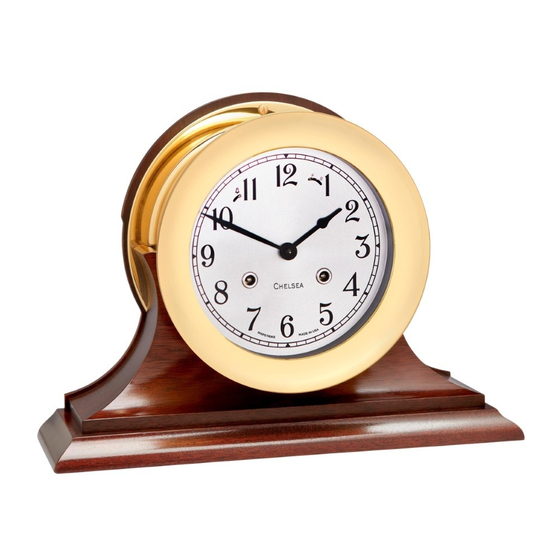
Table of Contents
Advertisement
Quick Links
Product Manual
SHIPStrIKE clocK and BaroMEtEr
c o n g ra t u l a t i o n s
A Chelsea clock is an exquisite time machine. Each is a work of art handcrafted by elite master clockmakers. For more
than a century, Chelsea craftsmen have created instruments whose beauty and workmanship enhance their extraordinary
functionality and durability.
Chelsea clocks sail the seas with the United States military, grace the ocean's most impressive yachts, and bear witness
to meetings of heads of state, presidents, princes, and kings of rock and roll. Chelsea clocks are treasured by collectors,
cherished from one generation to the next, and given as gifts to some of the luckiest people in the world.
Whether you purchased a handsome Chelsea clock or received one as a gift, you can be sure that Chelsea's master
clockmakers have taken exceptional care to produce one of the world's finest instruments.
S h i p s t r i ke M e c h a n i c a l c l o c k
WIndInG tHE clocK
Clocks leave our factory fully wound. Remove the black tube from the winding arbor on the front of the clock (save the
tube and replace it when shipping the clock or when you are away for extended periods). Each full winding will power
the clock for approximately eight days; however, for convenience we suggest you routinely rewind it at about the same
time every week.
SEttInG tHE tIME
To set the time, turn the minute hand clockwise to the correct time, stopping at each hour and half-hour point to allow
the bells to strike their full count. the hour hand should never be moved manually; all adjustments should be made by
moving the minute hand.
When moving the minute hand, the correct strike count may not sound at the first chime point, but this will self-correct
at the next full-hour point. Do not force the hands when setting the time. If they lock at any point, turn the minute hand
backwards through one striking position, then continue as above.
On the Shipstrike a "warn" occurs at 20 minutes past the hour and 10 minutes before the hour. This means that for the ten
minutes prior to each striking point, the gears and levers of the striking mechanism fall into correct position. Thus it is
advisable that whenever the striking clock is to be reset, the minute hand only should be slowly rotated forward (clock-
wise) to the next striking point and then the clock allowed to strike its full count. Adjustments should never be made
during a strike zone, only from 5 to 15 minutes past the hour or 25 to 15 minutes before the hour.
SIlEncInG tHE cHIME
You can turn off the striking mechanism by sliding the pin near the "11" on the clock's dial fully away from the bell sym-
bol. Do not shut off the strike while the clock is striking. To resume striking mode, slide the pin fully toward the bell.
Two Hundred Eighty Four Everett Avenue, Chelsea, Massachusetts 02150-1515 | Tel 617 884-0250 | chelseaclock.com
Advertisement
Table of Contents

Summary of Contents for Chelsea Shipstrike
- Page 1 On the Shipstrike a “warn” occurs at 20 minutes past the hour and 10 minutes before the hour. This means that for the ten minutes prior to each striking point, the gears and levers of the striking mechanism fall into correct position. Thus it is advisable that whenever the striking clock is to be reset, the minute hand only should be slowly rotated forward (clock- wise) to the next striking point and then the clock allowed to strike its full count.
- Page 2 InStallInG tHE BattErY The Chelsea Shipstrike clock with quartz movement requires a size "AA" alkaline battery. A fully charged battery should operate the clock for about a year. Please note that old batteries left in the clock may leak and cause damage not cov- ered by the warranty.
- Page 3 SEttInG For local altItudE When a Chelsea barometer leaves our factory it is adjusted to register pressure at sea level, which is the standard way to measure barometric pressure regardless of location or altitude. Since atmospheric pressure decreases as altitude increas- es, if you are in a higher altitude location it will be necessary for you to adjust the barometer to give you a reading cor- rected to sea level.


Need help?
Do you have a question about the Shipstrike and is the answer not in the manual?
Questions and answers
On a 6" Chelsea ShipStrike clock, does the strike main spring unwind when the strike is turned off? Also, my clock still has the plastic thread that protects the hammer during shipment. If I leave it in will that be problem My clock is an 04.
The strike main spring does not unwind when the strike is turned off on a 6" Chelsea ShipStrike clock. There is no information provided about whether it is a problem to leave the plastic thread that protects the hammer during shipment in a Chelsea ShipStrike clock model 04.
This answer is automatically generated